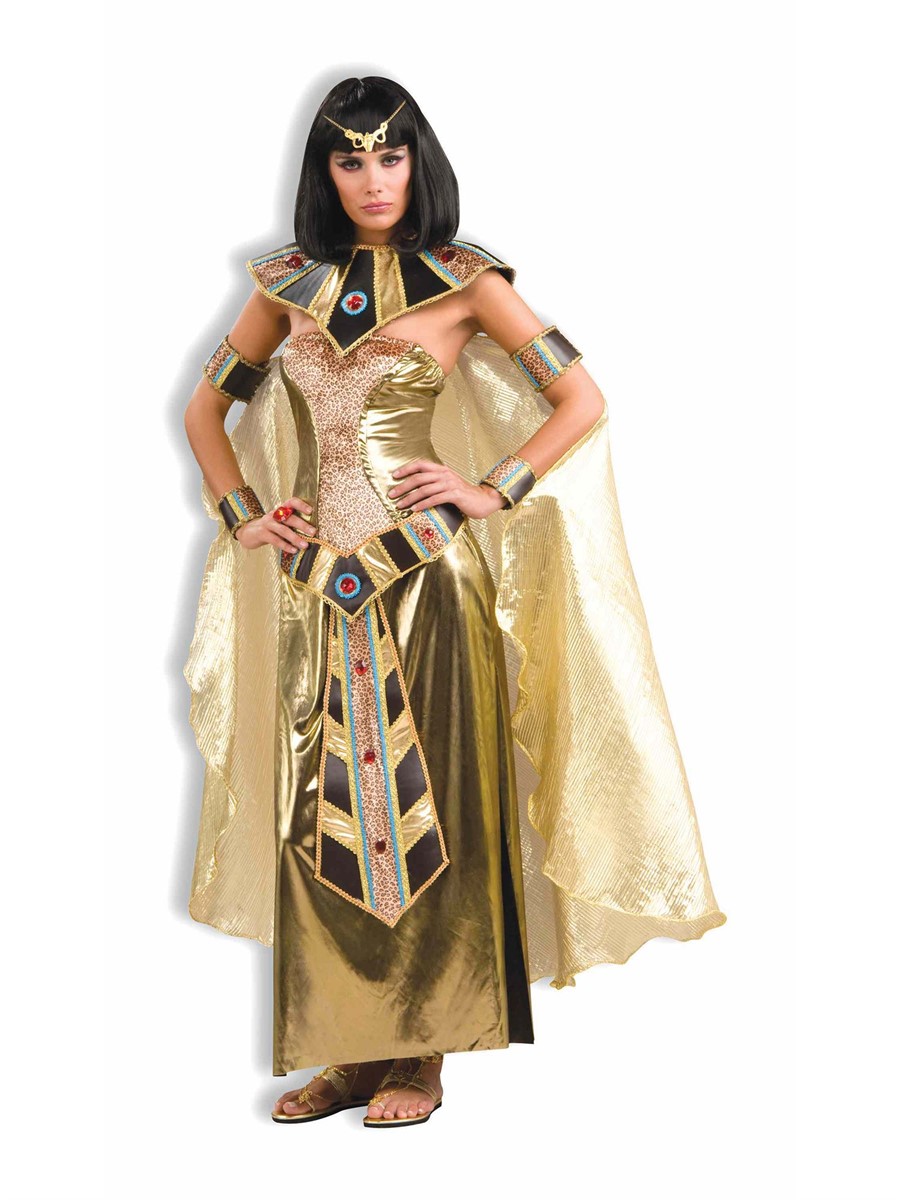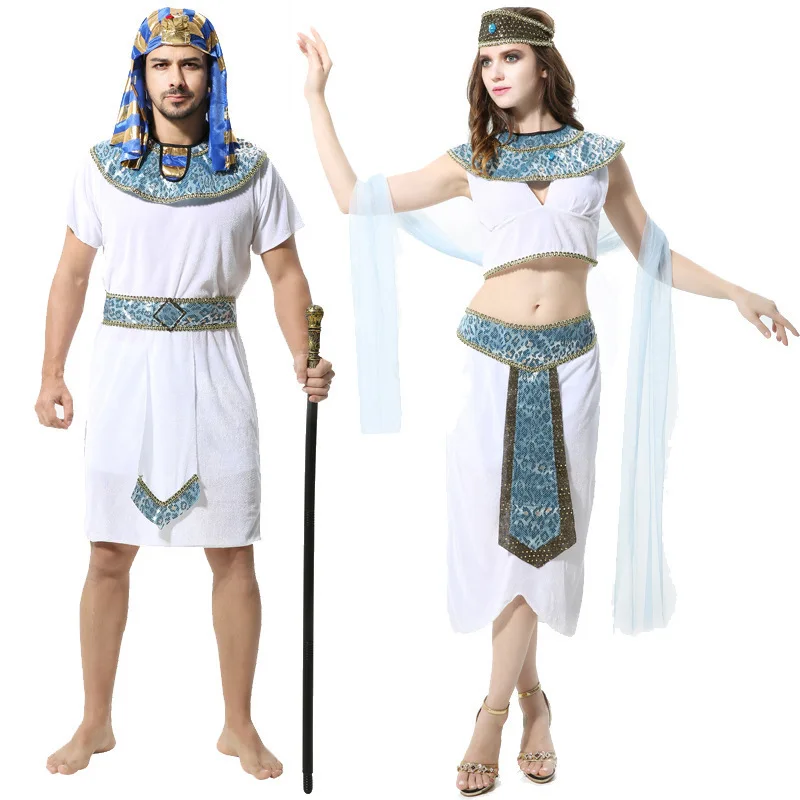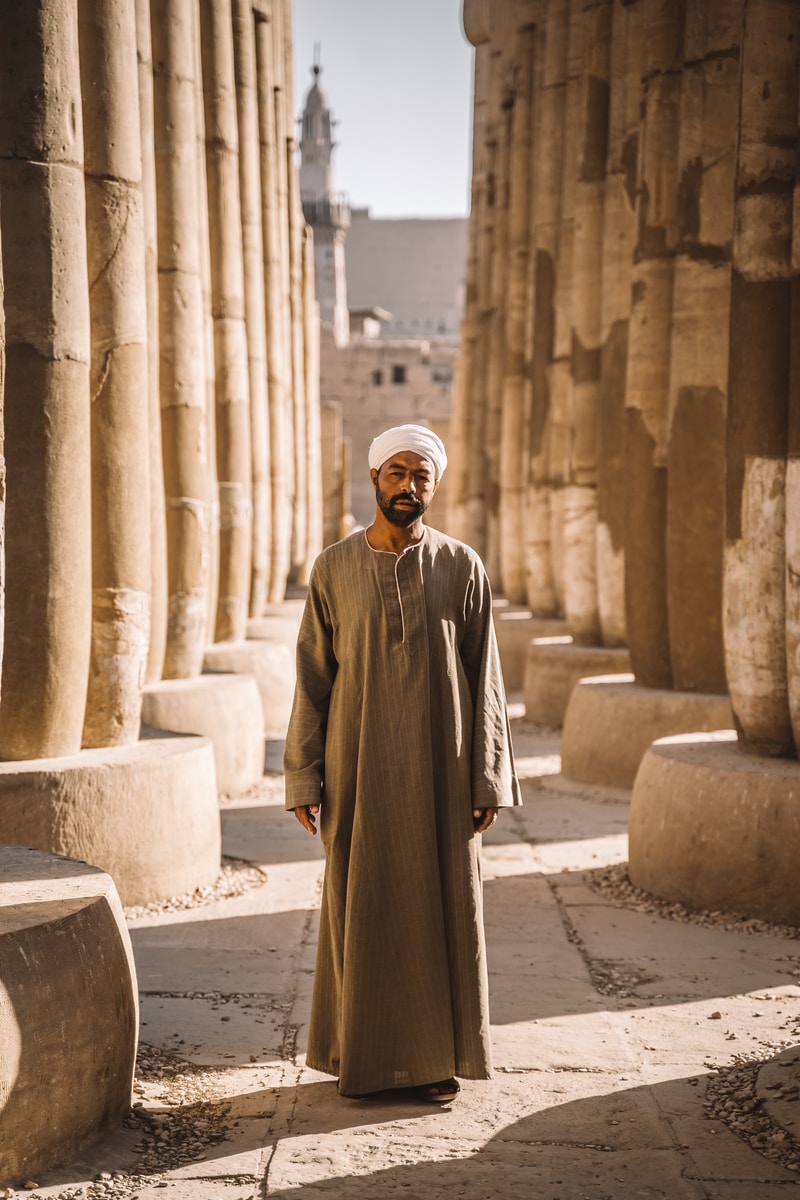
Egyptian Goddess Adult Costume
Most clothing of the ancient Egyptians was made of linen. Sheep's wool, goat hair and palm fiber were also available. Cotton only became common in the 1st century A.D., and silk after the 7th century A.D. Color, quality of the cloth, and decoration created more expensive varieties. Worn clothing would be reused since clothing was a valuable.

Fashion Party Ancient Egypt King Queen Clothing Pharaoh Cleopatra
Egyptian clothing is almost always white, the natural color of flax, because it was hard to dye linen. Flax plants. Wikimedia Commons. MEN'S CLOTHING. The most common piece of clothing worn by men was called a kilt. The men in the picture below are wearing kilts. A kilt is a skirt that wraps around the body and is tied with a belt.

Queen Of Egypt Ruler Cleopatra Dress Drapes Egyptian Costume Attire
The Galabeya is a traditional and historical part of Egyptian culture. Mostly seen in the Nile Valley but stretching to Upper Egypt, this attire has been worn in farming communities for hundreds of years.. Similar traditional clothing is worn across the Arab region as well, with slight differences. A variety of colors of men's galabeyas,.

Pinterest Robe egyptienne, Mode égypte, Costume de déesse
Ancient Egyptian clothes were worn in the country from the Neolithic period (before 3100 BC) to the fall of the Ptolemaic Kingdom and the death of Cleopatra in 30 BC. The clothing in ancient Egypt are mainly white then adorned with multiple colored patterns, plant dyes, precious jewels, and gems. The fabric used in making the cloth is mainly.

DRESS LIKE AN EGYPTIAN Egyptian fashion, Egyptian costume, Ancient
Hits: 3984. National costume of Egypt. Long and loose multi-layered outfits and NO ancient wrap-around garments. When people hear a phrase "Egyptian traditional clothing", they think about the attire of the Ancient Egypt. But actually, the folk dress used in modern Egypt differs much from the wrap-around garments that barely covered the.
1000+ images about Traditional Clothing Egypt on Pinterest
Egyptian Men's Traditional Clothing. The go-to folk or farmer outfit of Egyptian men also consists of a Gallebaya. Though in this case, the baggy pants are optional. In addition to that, they also wear one or more outer layers, a headdress, as well as shoes. The men's Gallebaya frequently comes striped in vibrant colors, it has long yet.

Egypt's Sinai traditional colourful dress of bedouin people Egyptian
The clothing in Egypt is designed with keeping the climate in mind. While ancient Egyptians preferred linens among other fibers for clothing, in the modern time's preference for light fabrics remains intact.. Traditional jewelry like Jakid Necklace and earnings are popular during festivals and weddings. In urban areas ladies do wear jeans.

Egypt (Luxor) Another Egyptian man with traditional dress named
Jewelry was an integral part of ancient Egyptian fashion. Both men and women wore heavy bracelets, earrings, necklaces, and collars. The type and amount of jewelry worn often signified the individual's social status and wealth. Amulets, believed to protect the wearer, were a popular form of jewelry. Makeup, too, was a significant aspect of.

Franco Queen of The Nile Costume Egyptian clothing, Egyptian costume
Ancient Egyptian traditional clothes were made from locally sourced materials and were surprisingly egalitarian, with women mostly wearing the same clothes as men. There were, however, exceptions and the most elite members of Egyptian society showed remarkable style and fashion. The Gender-Free Fashion of Ancient Egyptian Clothes

Men's Egyptian Pharaoh Costume
Asma Wahba. Modern Egyptian clothing is a unique blend of fashion influenced by different regions and cultures, including Arab and African. The country has an ancient history, so the modern-day Egyptian people continue to wear traditional clothing that goes back centuries. Men primarily wear robes called jibbaahs, turbans or gutras, and.

Egyptian men wear. Including, • schenti • apron • crowns • chignon cape
Egypt is the internationally used name but not the name used by the people of the country. It derives from the Greek Aegyptos, which in turn probably comes from ancient Egyptian words referring to the land ( Hut-ka-ptah, or "house of the essence [ka] of Ptah," a local god). Western names derive from this, as does the word "Copt" (in Arabic, qibt ).

Pin de Raghda Zyada em fashoin José do egito, Moda egípcia, Roupas
The most important item of the traditional attire in Egypt was the "shenti". The shenti was a white skirt-like garment, a piece of fabric that every single man in ancient Egypt wore. You could wear it in a variety of styles and lengths.

Infusing Ancient Egyptian Fashion in Modern Day Style Egyptian
Traditional Clothing: Egypt had a range of traditional costumes. The farmers (fellahin) basically wear gallibayas. In the cities the upper classes adopted the clothes of their conquerors - Ottoman Turks from 1500s, and later European from 1798. To the south the Nubians have their own distinctive costume and across the desert the Bedouin also.

She who pwns people with history Photo Ancient egyptian clothing
The Egyptians used linen to make most of their clothing, a light and cool material, perfect for a hot climate. White was the most common choice of color, but they also used red, blue and yellow. Clothing was worn draped over the body and was either tied or sewn in a few places. Other items, made of wool, have been found more rarely, since tombs.

csökkentő Arashigaoka megszelídíthetetlen egypt traditional dress
Traditional clothing in Egypt showcases the diversity and heritage of the country. The quintessential Egyptian garment is the galabeya, a flowing robe worn by both men and women. It is often embellished with intricate embroidery, reflecting the craftsmanship and artistry of Egyptian culture. Women may also adorn themselves with vibrant.

Cleopatra Egyptian Adult Costume Egyptian Costumes
Fashion in ancient Egypt epitomized the concept of simplicity and ease in movement and remained relatively unchanged in this regard for over 3,000 years. Clothing and footwear differed in ornamentation between the upper and lower classes but, overall, men and women's clothing took the same basic forms in any era, quite unlike fashion in the modern era.